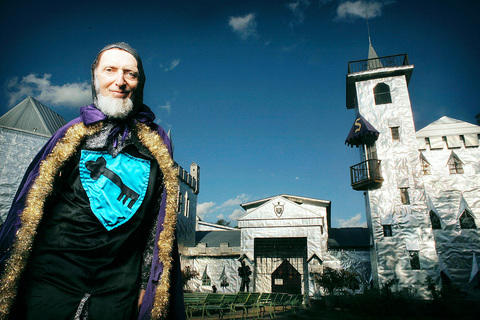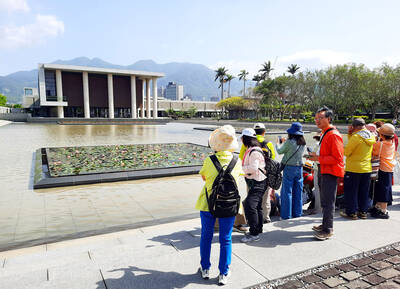Solomon's Castle, sometimes called Florida's real Magic Kingdom, rises from a swamp in the middle of Hardee County nowhere. In the castle are many gnomes. They are pointy-headed gnomes carved out of wood. A man's gnome is in his castle.
You ought to hear Howard Solomon talk about his gnomes. He goes on about them like a Borscht Belt comedian.
"I have made so many gnomes that I've learned their language. It's called gnomenclature. If you give them a feather it's a gnome de plume. If you put them on the stove it's a gnome on the range. If you put them on a piano it's a metrognome."

PHOTO: NY TIMES NEWS SERVICE
What do you call a gnome on a chair?
"A suppository."
Solomon is a little gnomish himself. He is about 1.63m and weighs 54kg when he is wet from a soaking in the moat. He wears a sailor's cap upside down and when it is dark as a dungeon in the bell tower his head appears a little pointy. He is somewhat wrinkled at 71. His chin hair, bristling like a shaving brush, prompts the question: Anyone seen Dr. Seuss lately?
Solomon began building in 1972. He didn't intend to build a castle, but when he realized he had bought a swamp he decided to build up instead of out. Solomon doesn't do safe, sensible things like the big-time contractors who are building condos and townhouses everywhere. He spent US$19,000 on lumber, but otherwise the Rembrandt of Reclamation gathered his materials from roadside junk.
Today Solomon's Castle is a well-known B-list tourist attraction near Arcadia. It is a throwback to Florida before the Big Mouse. It belongs to the era when tourist attractions were found on roadsides, behind gas stations, even in swamps -- and inevitably owned and operated by eccentrics.
It is terrible, truly terrible, to report that Solomon wants to sell his 3,658m2 castle. Asking price: US$2.5 million, or US$5.5 million with all the accessories.
Accessories include a 20m Spanish galleon, a dungeon and many, many gnomes.
The good news: Solomon admits the castle has been on the market for 15 years.
The old gnome may make his home at the castle for a long time yet.
In modern Florida, "in the sticks" often means a block or two outside the city limits. Solomon's Castle is authentically in the sticks.
For years Solomon Road was mud, but cars got stuck, so Solomon paved it. He put in a lot large enough to park tour buses. In a good year, more than 20,000 tourists pay US$10 a head to see his castle and get a tour, often from Solomon himself, who delivers quite a spiel.
Striking a pose in the lot in front of the castle, he says, "I'm out standing in my field."
Solomon's teachers in the New York public schools told his parents he was borderline retarded. He failed second grade but could do anything with his hands. He built cars from wood scraps and razor blades. One time he told his dad, "I invented a box without corners."
His dad said, "It's a bowl, dummy."
He was expelled from high school and sent to a trade school, where he was expelled again, mostly because he seemed more interested in becoming Henny Youngman than welding and hammering.
He was an unlikely soldier but served in Korea anyway. Later he followed his parents to Florida, settled in St. Petersburg with wife No. 1 and toiled as a carpenter. In 1962, Solomon moved his family to the Bahamas and began his career as an artist.
Trash was Solomon's artistic medium. A bedspring could be the spine of a crooked man. A rusting V-8 can might power a powerful fantasy automobile.
The "Da Vinci of Debris" was just warming up.
Solomon's Castle features buttresses, towers, a lighthouse, a drawbridge, a dungeon, a moat.
In 1991, Solomon built a full-sized galleon in the moat. It doubles as a restaurant and includes a poop deck, cannons and three masts. Inside are stained glass windows and a painting of a naked mermaid whose breasts are hidden behind a fishing net.
"We covered her so there would be no tittering in the restaurant."
Solomon often leads the groan-filled tours of his castle. Every room contains Solomon paintings and sculptures and toys. If Dali, Dr. Seuss and Willy Wonka were imprisoned in the same studio, they might produce Solomon's kind of art.
Every piece has a story.

When the South Vietnamese capital of Saigon fell to the North Vietnamese forces 50 years ago this week, it prompted a mass exodus of some 2 million people — hundreds of thousands fleeing perilously on small boats across open water to escape the communist regime. Many ultimately settled in Southern California’s Orange County in an area now known as “Little Saigon,” not far from Marine Corps Base Camp Pendleton, where the first refugees were airlifted upon reaching the US. The diaspora now also has significant populations in Virginia, Texas and Washington state, as well as in countries including France and Australia.

On April 17, Chinese Nationalist Party (KMT) Chairman Eric Chu (朱立倫) launched a bold campaign to revive and revitalize the KMT base by calling for an impromptu rally at the Taipei prosecutor’s offices to protest recent arrests of KMT recall campaigners over allegations of forgery and fraud involving signatures of dead voters. The protest had no time to apply for permits and was illegal, but that played into the sense of opposition grievance at alleged weaponization of the judiciary by the Democratic Progressive Party (DPP) to “annihilate” the opposition parties. Blamed for faltering recall campaigns and faced with a KMT chair

Article 2 of the Additional Articles of the Constitution of the Republic of China (中華民國憲法增修條文) stipulates that upon a vote of no confidence in the premier, the president can dissolve the legislature within 10 days. If the legislature is dissolved, a new legislative election must be held within 60 days, and the legislators’ terms will then be reckoned from that election. Two weeks ago Taipei Mayor Chiang Wan-an (蔣萬安) of the Chinese Nationalist Party (KMT) proposed that the legislature hold a vote of no confidence in the premier and dare the president to dissolve the legislature. The legislature is currently controlled

Dull functional structures dominate Taiwan’s cityscapes. But that’s slowly changing, thanks to talented architects and patrons with deep pockets. Since the start of the 21st century, the country has gained several alluring landmark buildings, including the two described below. NUNG CHAN MONASTERY Dharma Drum Mountain (法鼓山, DDM) is one of Taiwan’s most prominent religious organizations. Under the leadership of Buddhist Master Sheng Yen (聖嚴), who died in 2009, it developed into an international Buddhist foundation active in the spiritual, cultural and educational spheres. Since 2005, DDM’s principal base has been its sprawling hillside complex in New Taipei City’s Jinshan District (金山). But